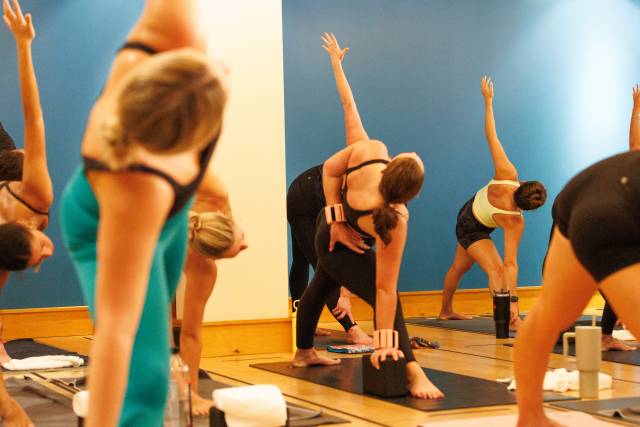Defeating Stress & Anxiety with a Daily Mindfulness Routine
In today’s fast-paced world, stress seems almost unavoidable. The pressure of balancing work, personal life, and various responsibilities can leave us feeling overwhelmed and drained. However, incorporating mindfulness into your daily routine can offer powerful relief and help you regain a sense of balance.
Mindfulness is the practice of being fully present and engaged in the current moment, without judgment. It involves cultivating awareness of your thoughts, feelings, and surroundings, which can significantly reduce stress. In yoga practice, meditative yoga practice is especially designed to help practitioners shift into a more relaxed state of inner awareness.
Stress Can Come in Many Forms
Stress manifests in countless ways, extending beyond the familiar external pressures of academic deadlines, family responsibilities, and career demands. We have to recognize that physical sources of stress, such as the strain of childbirth, trauma, and medical treatments, can also have profound effects on our well-being. These internal stressors can trigger conditions like telogen effluvium, a type of hair loss linked to significant stressors as they play on the human nervous system. Understanding that stress isn’t solely about psychological strain but also includes these physical challenges can help us approach our health, both physically and mentally, with a wider perspective and understanding.
Understanding Mindfulness
Before diving into creating a daily mindfulness routine, it’s important to understand what mindfulness truly entails. Mindfulness is a mental practice where you focus your attention on the present moment. Instead of being lost in regrets about the past or worries about the future, mindfulness encourages you to observe your thoughts and sensations as they occur. This practice helps you become more aware of your reactions to stress and provides a greater sense of control over your responses.
Basic Mindfulness Practice:
Breathing Awareness: Find a quiet space, sit comfortably, and focus on your breathing. Notice the sensation of air entering and leaving your nostrils, and the rise and fall of your chest or abdomen. When your mind wanders, gently bring your attention back to your breath.
Body Scan: Lie down or sit comfortably and systematically bring your attention to different parts of your body, from head to toe. Notice any sensations, tension, or areas of relaxation. This practice helps you connect with physical sensations and release tension.
Mindful Observation: Choose an object or scene to observe closely. Pay attention to the details, colors, textures, and shapes. This practice enhances your ability to focus and appreciate the present moment.
Crafting Your Daily Mindfulness Routine
Creating a daily mindfulness routine can transform your approach to stress and improve your overall well-being. Here’s a step-by-step guide to help you establish a practice that fits your lifestyle:
- Start Small: Begin with just five minutes a day. Consistency is more important than duration. Gradually increase the time as you become more comfortable with the practice.
- Choose the Right Time: Find a time that works best for you. Some people prefer to start their day with mindfulness, while others find it beneficial before bed. Experiment to see what fits your schedule and lifestyle.
- Create a Dedicated Space: Designate a specific area in your home for mindfulness practice. It could be a quiet corner with a comfortable chair or a mat. Having a designated space can help reinforce the habit and create a calming environment.
- Incorporate Mindfulness into Daily Activities: You don’t have to limit mindfulness to a specific practice. Integrate it into everyday tasks such as eating, walking, or washing dishes. For example, focus on the texture and flavor of your food while eating or notice the sensations in your feet as you walk.
- Track Your Progress: Keep a journal to reflect on your mindfulness practice. Note any changes in your stress levels, mood, or overall well-being. Tracking your progress can help you stay motivated and identify what works best for you.
Adding Yoga to Your Daily Routine
Yoga can complement your mindfulness practice beautifully. While it’s important to keep yoga references brief, it’s worth noting that yoga combines physical postures, breathing exercises, and meditation to promote relaxation and awareness. A few minutes of yoga each day can enhance your mindfulness practice by helping you connect more deeply with your body and mind.
Yoga Integration Tips:
- Morning Stretch: Start your day with a few simple yoga poses like Child’s Pose, Downward Dog, or Cat-Cow. These can help awaken your body and prepare you for a mindful day.
- Evening Relaxation: Incorporate gentle yoga stretches before bedtime to release any tension and prepare your body for restful sleep.
- Mindful Movement: During your yoga practice, focus on your breath and the sensations in your body. This enhances both your mindfulness and physical well-being.
Overcoming Daily Challenges
Building a new habit can be challenging, and mindfulness is no exception. Here are some common obstacles and tips to overcome them:
- Time Constraints: If you struggle to find time, start with short practices and gradually increase as your schedule allows. Even a few minutes can be effective.
- Restlessness: It’s normal to feel restless or distracted initially. Gently bring your focus back to your breath or the present moment whenever you notice your mind wandering.
- Expectations: Don’t set unrealistic expectations for yourself. Mindfulness is a practice, not a perfect state. Be patient and compassionate with yourself as you develop this new routine.
Mindfulness for Stress Relief: How to Create a Daily Routine That Works for You
Integrating mindfulness into your daily routine can provide significant relief from stress and enhance your overall quality of life. By starting with simple practices and gradually building a routine that suits your needs, you can create a mindful space in your day. Adding yoga can further support your mindfulness journey, offering a holistic approach to managing stress. Embrace the process, be patient with yourself, and enjoy the journey toward a more mindful and balanced life.







